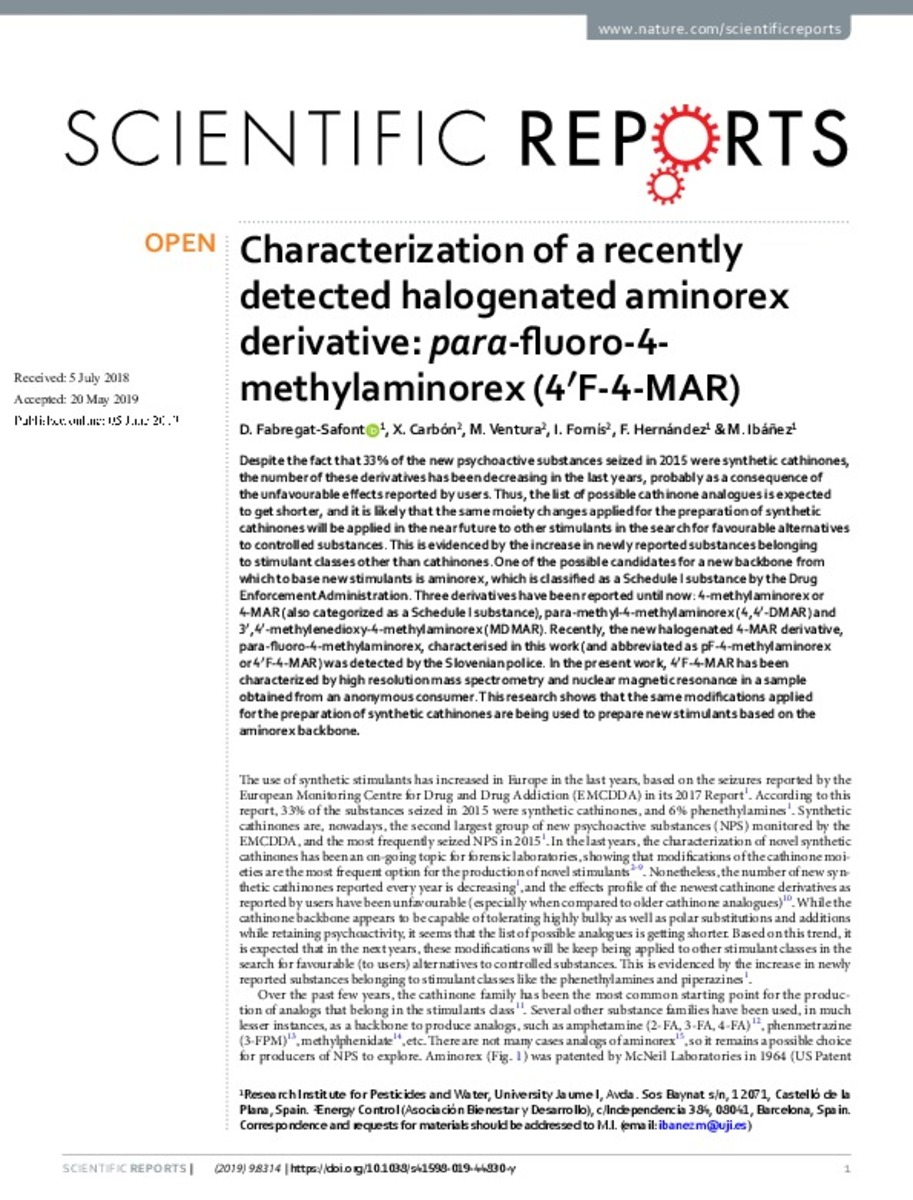Mostrar el registro sencillo del ítem
Characterization of a recently detected halogenated aminorex derivative: para-fluoro-4-methylaminorex (4′F-4-MAR)
| dc.contributor.author | Fabregat-Safont, David | |
| dc.contributor.author | Carbón, X. | |
| dc.contributor.author | Ventura, Mireia | |
| dc.contributor.author | Fornís, I. | |
| dc.contributor.author | Hernandez, Felix | |
| dc.contributor.author | Ibáñez, Maria | |
| dc.date.accessioned | 2019-07-05T18:34:08Z | |
| dc.date.available | 2019-07-05T18:34:08Z | |
| dc.date.issued | 2019 | |
| dc.identifier.citation | FABREGAT-SAFONT, D., et al. Characterization of a recently detected halogenated aminorex derivative: para-fluoro-4-methylaminorex (4′ F-4-MAR). Scientific reports, 2019, vol. 9, núm. 1, p. 8314 | ca_CA |
| dc.identifier.issn | 2045-2322 | |
| dc.identifier.uri | http://hdl.handle.net/10234/183130 | |
| dc.description.abstract | Despite the fact that 33% of the new psychoactive substances seized in 2015 were synthetic cathinones, the number of these derivatives has been decreasing in the last years, probably as a consequence of the unfavourable effects reported by users. Thus, the list of possible cathinone analogues is expected to get shorter, and it is likely that the same moiety changes applied for the preparation of synthetic cathinones will be applied in the near future to other stimulants in the search for favourable alternatives to controlled substances. This is evidenced by the increase in newly reported substances belonging to stimulant classes other than cathinones. One of the possible candidates for a new backbone from which to base new stimulants is aminorex, which is classified as a Schedule I substance by the Drug Enforcement Administration. Three derivatives have been reported until now: 4-methylaminorex or 4-MAR (also categorized as a Schedule I substance), para-methyl-4-methylaminorex (4,4′-DMAR) and 3′,4′-methylenedioxy-4-methylaminorex (MDMAR). Recently, the new halogenated 4-MAR derivative, para-fluoro-4-methylaminorex, characterised in this work (and abbreviated as pF-4-methylaminorex or 4′F-4-MAR) was detected by the Slovenian police. In the present work, 4′F-4-MAR has been characterized by high resolution mass spectrometry and nuclear magnetic resonance in a sample obtained from an anonymous consumer. This research shows that the same modifications applied for the preparation of synthetic cathinones are being used to prepare new stimulants based on the aminorex backbone. | ca_CA |
| dc.format.extent | 8 p. | ca_CA |
| dc.format.mimetype | application/pdf | ca_CA |
| dc.language.iso | eng | ca_CA |
| dc.publisher | Nature Research | ca_CA |
| dc.relation.isPartOf | Scientific reports, 2019, vol. 9, núm. 1, p. 8314 | ca_CA |
| dc.rights | Open Access This article is licensed under a Creative Commons Attribution 4.0 International License, which permits use, sharing, adaptation, distribution and reproduction in any medium or format, as long as you give appropriate credit to the original author(s) and the source, provide a link to the Creative Commons license, and indicate if changes were made. The images or other third party material in this article are included in the article’s Creative Commons license, unless indicated otherwise in a credit line to the material. If material is not included in the article’s Creative Commons license and your intended use is not permitted by statutory regulation or exceeds the permitted use, you will need to obtain permission directly from the copyright holder. To view a copy of this license, visit http://creativecommons.org/licenses/by/4.0/. | ca_CA |
| dc.rights | Atribución 4.0 Internacional | * |
| dc.rights.uri | http://creativecommons.org/licenses/by-sa/4.0/ | * |
| dc.title | Characterization of a recently detected halogenated aminorex derivative: para-fluoro-4-methylaminorex (4′F-4-MAR) | ca_CA |
| dc.type | info:eu-repo/semantics/article | ca_CA |
| dc.identifier.doi | https://doi.org/10.1038/s41598-019-44830-y | |
| dc.relation.projectID | D.F.-S., F.H. and M.I. acknowledge financial support from Generalitat Valenciana (Group of Excellence Prometeo II 2014/023, from Ministerio de Economía y Competitividad (Project: CTQ2015-65603-P, Spain) and from University Jaume I (UJI-B2018-19). Authors also acknowledge NPS-Euronet (HOME/2014/JDRUG/AG/DRUG/7086, European Union). D.F-S. acknowledges Ministerio de Educación, Cultura y Deporte for his predoctoral grant (Grant FPU15/02033, Spain). X.C., M.V. and I.F. acknowledge the grants from Subdirecció General de Drogodependències, Departament de Salut, Generalitat de Catalunya and Plan Nacional sobre Drogas. | ca_CA |
| dc.rights.accessRights | info:eu-repo/semantics/openAccess | ca_CA |
| dc.relation.publisherVersion | https://www.nature.com/articles/s41598-019-44830-y | ca_CA |
| dc.type.version | info:eu-repo/semantics/publishedVersion | ca_CA |
Ficheros en el ítem
Este ítem aparece en la(s) siguiente(s) colección(ones)
-
QFA_Articles [817]
Articles de publicacions periòdiques
Excepto si se señala otra cosa, la licencia del ítem se describe como: Open Access This article is licensed under a Creative Commons Attribution 4.0 International License, which permits use, sharing, adaptation, distribution and reproduction in any medium or format, as long as you give appropriate credit to the original author(s) and the source, provide a link to the Creative Commons license, and indicate if changes were made. The images or other third party material in this article are included in the article’s Creative Commons license, unless indicated otherwise in a credit line to the material. If material is not included in the article’s Creative Commons license and your intended use is not permitted by statutory regulation or exceeds the permitted use, you will need to obtain permission directly from the copyright holder. To view a copy of this license, visit http://creativecommons.org/licenses/by/4.0/.








